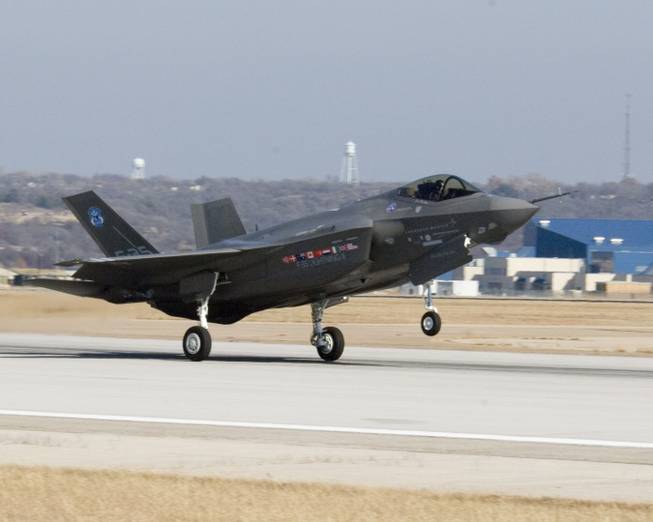
Neal Chapman/Lockheed Martin / AP
In this 2006 file photo, the first F-35 Lightning II Joint Strike Fighter takes off on its initial test flight from Lockheed Martin in Fort Worth, Texas.
Monday, Dec. 28, 2015 | 2 a.m.
The helmet
The pilot’s helmet is connected to the computer system and provides a heads-up display that including feeds from six cameras embedded in the aircraft’s skin. The system provides the pilot with a 360-degree infrared view of what’s around the plane, including what’s beneath it.
By the numbers
• Length: 51.4 feet (equivalent to about three full-sized SUVs)
• Wingspan:35 feet
• Weight: 29,300 pounds
• Maximum weigh: 70,000 pounds
• Top speed: Mach 1.6 (1,200 mph)
• Maximum G-rating: 9 (number of g's or multiples of gravitational pull)
• Weapons payload: 18,000 pounds
• Cost per aircraft: $134 million
• Number delivered to U.S. forces: 162
• Number the Air Force and Navy plan to purchase: 2,443
• Engine: Pratt & Whitney turbofan, capable of producing 40,000 pounds of thrust
It’s an aircraft like no other, in both its design and most definitely its cost.
The Lockheed Martin F-35 Lightning II is the most expensive weapons system in U.S. history, with a price tag of $400 billion for development and procurement.
The single-engine, single-seat plane’s manufacturer and supporters say it’s well worth the investment, brimming with technology that will make it one of the deadliest weapons in the sky — including stealth capability and sensors that will allow it to destroy enemy aircraft before their pilots know what hit them. In addition, the F-35 was built to be a workhorse that could be used by the Air Force, Navy and Marines alike and would replace a number of aging planes, including the F-16, F-15, F-18 and A-10 fighters and attack aircraft.
But opponents of the Lightning II, which also is known as the Joint Strike Fighter and has been declared operational by the U.S. Marines, cite cost overruns, production delays, problems with its components and concerns over its performance in saying the Department of Defense should abandon its plans to buy nearly 2,500 of them.
Nevada has a relationship with the controversial plane. In March 2013, Nellis Air Force Base received its first four F-35A fighters for testing.
Criticism
When the Department of Defense announced the program in 2001, it said the first squadron of Lighting IIs would be combat ready in 2010. But the program fell behind schedule amid cost overruns and delays. Among the problems: The heads-up display in the helmet was showing jerky video feeds, and it gave off a green glow at night that hampered pilots’ vision; a cracked turbine blade was discovered after a test in 2013, prompting the Pentagon to temporarily ground the fleet; and testers discovered that the force of the ejection seat could cause pilots’ heads to snap backward or forward violently enough to cause injury. A recent report said tests showed the F-35 could neither effectively attack nor escape from one of the aircraft it’s designed to replace —the F-16. Lockheed Martin said the Lightning II that was used in the test wasn’t outfitted with full sensors that would have allowed it to detect and destroy the F-16 from a great distance, eliminating the need for a dogfight. That’s what the plane is designed to do, the manufacturer said.
About the Lightning II
• The Lightning II’s design, materials and electronics make it virtually undetectable to enemy radar. The aircraft carries its bombs, missiles and other weapons internally, in bays covered by doors. This increases stealth by reducing surfaces that radar beams can bounce off of.
• The F-35 is a fly-by-wire aircraft, meaning the control stick isn’t mechanically linked to the ailerons and rudder but rather is connected through electronics. Four layers of redundancies are built into the system to ensure the fly-by-wire connection remains operational.
• The aircraft’s computer is powered by a core processor that can perform more than 400 billion operations per second. Its sensors can detect enemy radar and other electronic emissions, which the F-35 can share securely with commanders on the ground, at sea or in the air.
Standard weapons
• 25-millimeter GAU-22/A four-barreled Gatling gun, which can fire up to 3,300 rounds per minute
Did you know?
Eleven foreign nations plan to purchase F-35s. They are Great Britain, Italy, the Netherlands, Turkey, Australia, Norway, Denmark, Canada, Israel, South Korea and Japan.
• Two AIM-120C medium-range air-to-air missiles
• Two 2,000-pound GBU-31 JDAM computer- and GPS-guided smart bombs
Variants
• F-35B: This version features a special propulsion system that allows it to take off from short runways and land by descending straight down, akin to a helicopter. The jet exhaust pipe can be swiveled to direct the thrust downward, while exhaust ducts in the wings help give the plane stability as it rises and descends. There’s also a lift fan near the front of the plane.
• F-35C: Featuring larger wings and stronger landing gear, this version is tailored for use on aircraft carriers. The design allows it to be launched by catapult and to reach a slow airspeed for arrestor-hook landings. In addition, the aircraft’s wingtips can be folded to make it easier to store on carriers.

Join the Discussion:
Check this out for a full explanation of our conversion to the LiveFyre commenting system and instructions on how to sign up for an account.
Full comments policy